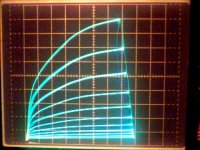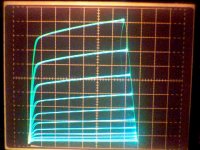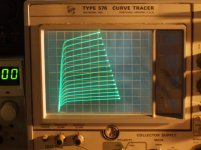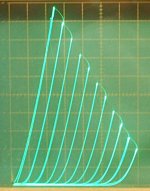Thank you kodabmx and tubelab you just confirm that is not a good idea, yes is a SE case, I recently built a SE EL84, 12Ax7 driver and was a total disappointment so I have all components OTP included so I was looking for a good idea for rebuild, follow your suggestionI will abandon the idea of a twin triode in parallel SE mode with available a 5k OTP, I put my eye on a pentode instead the Russian 6P41S, looks very promising ....thanks again and all the best
What are you guys’ favorite small-signal tri/pent combos? There seem to be a lot of cheap ones out there intended for TV mixer and IF. Mu values on the triodes all over the place. Not necessarily worried about keeping 7199 basing or anything - just looking for cheapo stuff to get a dozen or two to go into my stash for Armageddon.
Rewire the socket, a 6U8 should work in place of a 7199...
Armageddon...the metal elements of a tube may stand up better to EMP than any P/N junction in a solid state device....
Armageddon...the metal elements of a tube may stand up better to EMP than any P/N junction in a solid state device....
Tubelab tried a bunch of t/p tubes for his "Magic" front end; should be searchable.
I bought a bunch of 6KR8's and its Compactron cousin for a ST70 style front end but haven't tried any yet.
I bought a bunch of 6KR8's and its Compactron cousin for a ST70 style front end but haven't tried any yet.
PCF200: High gm frame grid pentode, high µ triode, resembling a 12AT7 half;
PCF201: High gm frame grid remote cutoff pentode, medium µ triode, resembling a 12AU7 half.
Both require a 10 pin socket which isn't very common outside of Europe.
Best regards!
PCF201: High gm frame grid remote cutoff pentode, medium µ triode, resembling a 12AU7 half.
Both require a 10 pin socket which isn't very common outside of Europe.
Best regards!
Rewire the socket, a 6U8 should work in place of a 7199...
Armageddon...the metal elements of a tube may stand up better to EMP than any P/N junction in a solid state device....
I know the 6U8, and so does everybody else, which drives the prices higher. I was doing a little digging and found no less than 10 possible types in the RCA receiving tube manual, some of which can be had for $3. I was wondering if anyone had any success with any of them, and maybe which are the best candidates to try, then stock up on.
I’ve been stockpiling cheap power tubes I can make use of when Armageddon comes - that is, when the money (and perhaps tube supply) dries up. Gotta think about small signal types too, unless I want to get stuck paying an arm and a leg for mundane stuff like 12ax7’s, 6SN7’s, and 7199’s 10 years from now. Been doing lifetime buys for all my solid state work over the last 3 years, now expanding to include tubes.
For 7199 here are some similar tubes:
6U8
6GH8
6AX8/6KD8
6AN8
6EA8
7687 an upgraded 7199
6CX8
If you are designing from scratch, no need to copy the 7199. Anatoliy (Wavebourn) likes the 6F12P (framegrid Pent and Triode, both gm 19000)
Very interesting tube, can do Concertina or LTP.
Lots of 9DX base tubes with a triode plus a frame grid pentode, 6KV8, 6KR8, 6LY8, 6LQ8.
Want a D3a for a couple of bucks?
Look at 9KC6 with +12V on grid 3 (wrt cathode) it has a gm of 40,000 at 28 mA. Pics below (normal 9KC6 curves, and 9KC6 with +12V on grid3)
12/ 6BV11 with +12V on grid 3 is similar. Except the twin pentodes turn into twin 6AU6 pentodes.
Then there are the 6BN11, 6J11, 8CB11 dual pentodes. These are (near to) 6EW6 pentodes (gm 13000 at 11 mA) (g3 can stay at 0V here)
A cheap driver tube is the 6197. (6CL6 clone) Curves below. I've gotten these tubes in quantity below $0.50 each. Nearly the same as a 12BY7 except slightly lower gm.
And there is the 6HZ8 pent./ triode combo which has an oversize 6CL6/6197 pentode (with a little higher gm too, equal to 12BY7) and a nice triode in one 9 pin bottle.
Then there is the low cost 12HL7 frame grid pent. with twice the gm 21000 (see super triode curves pic below).
6JC6 gets you a cheap 9 pin frame grid pentode. gm 16000
The main thing you have to look out for with frame grid tubes is microphonics and oscillation (use stoppers).
Pinout compatibles (7 pin)
(these all fit on Pete Milletts Engineers Amp boards):
5JK6 frame grid is similar to 6JC6. (the 6JK6 is expensive) gm 18000
6EW6 gm 14000
8136 gm 9800
6CB6 gm 8000
6U8
6GH8
6AX8/6KD8
6AN8
6EA8
7687 an upgraded 7199
6CX8
If you are designing from scratch, no need to copy the 7199. Anatoliy (Wavebourn) likes the 6F12P (framegrid Pent and Triode, both gm 19000)
Very interesting tube, can do Concertina or LTP.
Lots of 9DX base tubes with a triode plus a frame grid pentode, 6KV8, 6KR8, 6LY8, 6LQ8.
Want a D3a for a couple of bucks?
Look at 9KC6 with +12V on grid 3 (wrt cathode) it has a gm of 40,000 at 28 mA. Pics below (normal 9KC6 curves, and 9KC6 with +12V on grid3)
12/ 6BV11 with +12V on grid 3 is similar. Except the twin pentodes turn into twin 6AU6 pentodes.
Then there are the 6BN11, 6J11, 8CB11 dual pentodes. These are (near to) 6EW6 pentodes (gm 13000 at 11 mA) (g3 can stay at 0V here)
A cheap driver tube is the 6197. (6CL6 clone) Curves below. I've gotten these tubes in quantity below $0.50 each. Nearly the same as a 12BY7 except slightly lower gm.
And there is the 6HZ8 pent./ triode combo which has an oversize 6CL6/6197 pentode (with a little higher gm too, equal to 12BY7) and a nice triode in one 9 pin bottle.
Then there is the low cost 12HL7 frame grid pent. with twice the gm 21000 (see super triode curves pic below).
6JC6 gets you a cheap 9 pin frame grid pentode. gm 16000
The main thing you have to look out for with frame grid tubes is microphonics and oscillation (use stoppers).
Pinout compatibles (7 pin)
(these all fit on Pete Milletts Engineers Amp boards):
5JK6 frame grid is similar to 6JC6. (the 6JK6 is expensive) gm 18000
6EW6 gm 14000
8136 gm 9800
6CB6 gm 8000
Attachments
Last edited:
Thanks for the additional suggestions. The gamut of 6LF8/6LQ8/6KR8/6kV8 were already the highlighted ones on the list as being viable candidates to design in. Any of this would be for new design and “experiments”. And I’d already loaded up on those 6EW6 pentodes on my last big order. They stuck out as particularly desirable for high gain, and even current-source duty (when no-sand is a design parameter/goal/constraint).
Oscillation/stoppers yes, but microphonics? When frame grid tubes were widely introduced into the market here, at least German manufacturers advertised them to be less microphonic than wire wound grid tubes, which suddenly makes sense due to the more rigid and stiff frame construction.The main thing you have to look out for with frame grid tubes is microphonics and oscillation (use stoppers).
Best regards!
Oscillation/stoppers yes, but microphonics?
Well, that's good to hear.
I've heard one frame grid tube described as the sound of a 100 pianos when tapped. I suppose a problem could be with NOS tubes being shipped around so much that the mica supports get loose. The close spacing of the grid 1 to cathode could make them ultra sensitive to vibration if the mica support allows it. One just needs to check I guess.
12HL7 appears to be one of the rare (frame grid) tubes that has relaxed grid 1 to cathode spacing. Usually most of these frame grid tube designs were pushed to the limit (just like most other tubes) to get the max gm by minimal spacing. Notice 12GN7/12HG7 which are identical in construction to the 12HL7, but have almost twice the gm of the 12HL7. Similarly the 9KC6 at 40000 gm.
Selecting thru 12HL7 tubes on the curve tracer, one can find a fair percentage that have triode curves that are near DHT quality. (triode curves, in above post and below)
Another oddity I've seen is the 6JC6 frame grid tube. The US made ones tend to have typical mediocre triode mode curves. But some Japan made ones have remarkable triode curves. (Got them cheap via a tube sale. I almost threw them out since they had poor looking pentode curves, but I found they could be fixed up with the g3 voltage trick. Then I noticed the triode curves were real nice too. )
The 9DX base frame grid tubes also have a high success rate for great triode curves (the high gm pent. in triode mode).
For power tubes, we have the "new" series Schade scheme (UnSet, CED at Tubelab) which can turn the meanest TV "Sweep" tube into a 211 like clone, except still working at practical B+ and output Z. This "new" series Schade scheme is quite amenable to paralleling tubes for more power too, since it gives them all perfectly matched "triode" curves.
pics:
a) 12HL7 in triode mode
b) 21HB5A TV Sweep with "new" series Schade (UnSet, CED)
c) a cheap dual DHP in triode mode
d) 4P1L DHP in normal pentode mode
e) 4P1L with +15V on g3 fix
f) 4P1L in triode mode
g) 211 DHT curves
Attachments
-
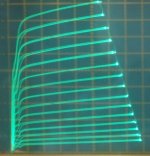 4P1L_81V_p6Vstep_5mA_P15Vg3.jpg83.5 KB · Views: 400
4P1L_81V_p6Vstep_5mA_P15Vg3.jpg83.5 KB · Views: 400 -
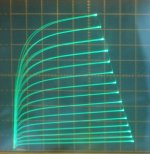 4P1L_81V_p6step_5mA_0g3.jpg93.5 KB · Views: 358
4P1L_81V_p6step_5mA_0g3.jpg93.5 KB · Views: 358 -
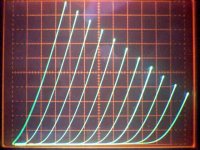 Perfect_Triode.jpg163.5 KB · Views: 370
Perfect_Triode.jpg163.5 KB · Views: 370 -
 21HB5A_Corr_Schade.jpg641.7 KB · Views: 356
21HB5A_Corr_Schade.jpg641.7 KB · Views: 356 -
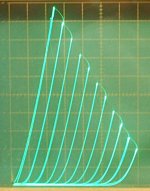 TFH_in_triode.jpg97.9 KB · Views: 377
TFH_in_triode.jpg97.9 KB · Views: 377 -
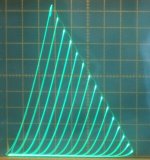 4P1L_p6Vstep_10mA.jpg89.2 KB · Views: 128
4P1L_p6Vstep_10mA.jpg89.2 KB · Views: 128 -
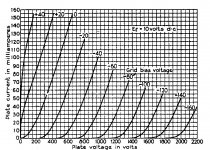 211_datasheet-curves.jpg329.2 KB · Views: 132
211_datasheet-curves.jpg329.2 KB · Views: 132
Last edited:
I've heard one frame grid tube described as the sound of a 100 pianos when tapped.
I have seen some dead quiet frame grid tubes, and some screamers. Overall they seem a bit quieter than conventional wound grid tubes when operated at high gains (equal gain in both types of tubes).
The high Gm of these tubes allows for some extreme amounts of gain when operated into a bootstrapped near infinite load impedance. At gains of well over 1000 V/V any tube gets microphonic and noisy.
Stuff that into the input stage of a guitar amp and you get feedback from the speaker. Wound grid tubes will get worse (more microphonic) over time if the tube is subject to vibration from the speaker. I think I am on my 4th or 5th 18FW6 in my little 4 watt guitar amp in 3 years of use. I have not built a frame grid input guitar amp yet, but it's on the bucket list.
Another oddity I've seen is the 6JC6 frame grid tube.
I think all of my 6JC6's are the same US brand. The 6JD6 is another from the same mold, but even the data sheets have different descriptions. GE calls it a "sharp cutoff pentode" while RCA says "cutoff characteristic approaching semiremote." I do see some small differences between the two brands in the UNSET amp. This can be fixed with a tweak to the feedback resistor, but some of these tubes are cross branded.
The 6KT6 is another from the same mold. I have some US made tubes and some Japanese made tubes. Again, they are different.
The 6EJ7 and 6EH7 are similar tubes, the 6EJ7 is sharp cutoff, and the 6EH7 is remote cutoff. I worked in a TV repair shop in the late 60's when these tubes hit the market, that was a Philco authorized warranty shop. The tubes came from several different US makers, and at least two European makers We had to roll through a hand full of tubes to find one that wouldn't oscillate in the TV under weak signal conditions. One of the US brands was unusable, but I can't remember which one.
All of these tubes look different when plugged into a conventional curve tracer. Once wired into a CED circuit they will behave in a similar manner due to the plate to grid feedback. Rolling through about 20 random tubes in the input stage of an UNSET board running at 10 watts of power output shows only 0.1 to 0.2% THD difference. The 6EH7 remote cutoff tube is the worse case (expected).
For power tubes, we have the "new" series Schade scheme
It works on small tubes too. The tubes discussed here were my first test subjects since they were real cheap at one time. The UNSET board uses any of these for the driver, and any of several TV sweep tubes for the output. Both are wired in CED configuration.
can turn the meanest TV "Sweep" tube into a 211 like clone, except still working at practical B+ and output Z.
You can run them at 211 voltages too since the screen stays at a mild mannered 150 to 175 volts. I have only been to 650 volts, the limit of my power supply.
6EJ7 = EF184, 6EH7 = EF183, aren't they? I recall that tube counts in common TV IF strips were diminished by one (in comparison with their predecessors EF80/6BX6 or EF85/6BY7) after they had been introduced into the market in the 1960ies. At least the EF184 has found some use in audio applications yet. Morgan Jones recommended it as a LTP CCS.
Best regards!
Best regards!
Last edited:
e) 4P1L with +15V on g3 fix
Amazing
Thanks smoking-amp....
The 4P1L looks more promising now....BJT like curves from a valve.Lovely 🙂
https://www.diyaudio.com/forums/att...evision-tubes-4p1l_81v_p6vstep_5ma_p15vg3-jpg
Amazing
Thanks smoking-amp....
The 4P1L looks more promising now....BJT like curves from a valve.Lovely 🙂
https://www.diyaudio.com/forums/att...evision-tubes-4p1l_81v_p6vstep_5ma_p15vg3-jpg
😉 now we can determinate the Early voltage from the... anode curvesAmazing
Thanks smoking-amp....
The 4P1L looks more promising now....BJT like curves from a valve.Lovely 🙂
https://www.diyaudio.com/forums/att...evision-tubes-4p1l_81v_p6vstep_5ma_p15vg3-jpg

Is 4P1L really a television tube?
Probably not. I see it described as related to RL4/2P6, which are described as "End-un senderstufen", which seems to translate to output and signal driver.
I just mentioned it since it responds to the positive V on g3 fix well.
Another tube that seems useless at first glance is the 6LE8 color matrix demodulator tube. +16V on grid 3 does wonders for its pentode curves. Can often be found for cheap.
4P1L may have some value for owners of a German VE 301 »Volksempfänger« radio. Providing an adaptor from Loctal to the European B5 socket, it may replace a worn out RES 164 output tube.
Best regards!
Best regards!
End-und senderstufen = output and transmitter stagesProbably not. I see it described as related to RL4/2P6, which are described as "End-un senderstufen", which seems to translate to output and signal driver.
- Home
- Amplifiers
- Tubes / Valves
- Those Magnificent Television Tubes
